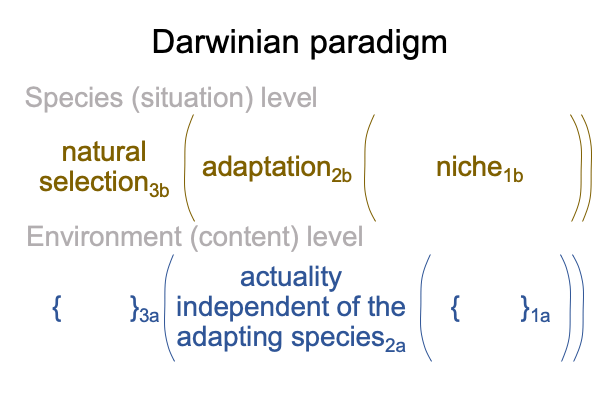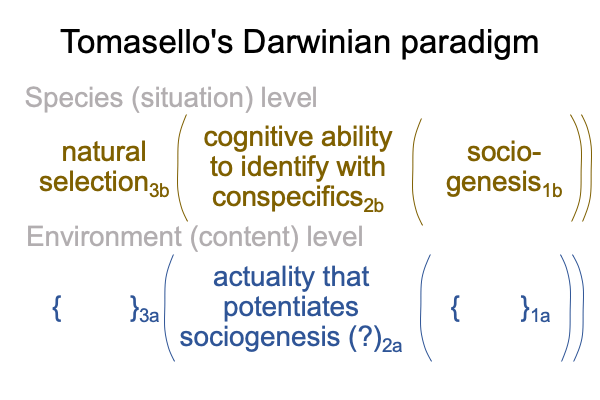The Evolution of Talk: A Note on How to Proceed (Part 1 of 1)
EOT 0001 The evolution of talk is not the same as the evolution of language.
Language evolves in the milieu of hand-talk.
So, what is the story?
0002 A course on the topic of human evolution is already on the market.
See Razie Mah’s, A Course on the Human Niche, consisting of the masterwork, plus four commentaries.
The Human Niche
Comments on Clive Gamble, John Gowlett and Robin Dunbar’s Book (2014) Thinking Big
Comments on Derek Bickerton’s Book (2014) More Than Nature Needs
Comments on Robert Berwick and Noam Chomsky’s Book (2016) Why Only Us?
Comments on Steven Mithen’s Book (1996) The Prehistory of Mind.
0003 The works are available for purchase at various e-book venues. In order to conduct the course, purchase the e-book to read on a tablet (or as a PDF to print). The class is not didactic. It is Socratic. The style is read and discuss. The text is broken into points. Each point can be discussed. So, a leisurely class may open the text, read out loud and ask what the point suggests.
0004 The masterwork came out in 2018 and is still highly relevant to inquiry into the Lebenswelt that we evolved in.
How so?
The human niche is the potential of triadic relations.
No other course on human evolution poses this ground-breaking hypothesis.
0005 Nonetheless, six years later, Razie Mah adds to the first course with a second, consisting in two sequences of blogs. This blog-inclusive (as well as e-book exclusive) course serves as a supplement to the master course, especially in regards to the evolution of talk.
0006 The first sequence is collated and rounded out in a compilation, titled, Comments on Michael Tomasello’s Arc of Inquiry (1999-2019), making the blogs and the compilation ideal for a guided- and home-schooling course.
Michael Tomasello worked at the Max Planck Institute for Evolutionary Anthropology for twenty years. He wrote a series of books on the evolution of human cognition, communication, thinking, morality and so on. In short, his books cover the evolution of the stuff of talk.
0007 Here is a list of the five commentaries in this first sequence.
One: Looking at Michael Tomasello’s Book (1999) “The Cultural Origins of Human Cognition”
(January 18-31, 2024, 12 blogs, 0-82 points)
Two: Looking at Michael Tomasello’s Book (2008) “Origins of Human Communication”
(January 17-4, 2024, 12 blogs, 83-186 points)
Three: Looking at Michael Thomasello’s Book (2014) “A Natural History of Human Thinking”
(February 29-5, 2024, 22 blogs, 187-388 points, completes Part 1 of Comments, see below)
Four: Looking at Michael Tomasello’s Book (2016) “A Natural History of Human Morality”
(March 26-1, 2024, 22 blogs, 389-600 points)
Five: Comments on Michael Tomasello’s Book (2019) “Becoming Human”
(points 601-793 are in Comments on Michael Tomasello’s Arc of Inquiry (1999-2019) Part 2, by Razie Mah, available at smashwords and other e-book venues)
0008 Yes, to complete the course, one needs to purchase Part 2.
How sneaky is that?
So, that is the meaning of “blog-inclusive and e-book exclusive”.
0009 The second sequence is collated in the compilation, titled, Synaesthesia and The Bicameral Mind in Human Evolution. This compilation packages two commentaries on human evolution and sets the scene for a study of the first singularity.
This list continues the previous numbering.
Six: Looking at Steven Mithen’s Book (2024) “The Language Puzzle”
(September 29-4, 2025, 23 blogs, 0-235 points)
Seven: A First Look at Julian Jaynes’s Book (1976) “The Origin of Consciousness in the Breakdown of the Bicameral Mind”.
(October 31-8, 2025, 21 blogs, 235-525 points)
0010 Overall, this hybrid online-onsale course on the evolution of talk, by Razie Mah, are available for sampling (on the blog) and may be purchased at any e-book venue.
Comments on Michael Tomasello’s Arc of Inquiry (1999-2019), Parts 1 and 2 contains 753 points.
Synaesthesia and the Bicameral Mind in Human Evolution contains 525 points.
0011 Total: 1278 points, 21 hours at 1 minute per point.
Perhaps, this online course lasts around 4 to 5 weeks.
Enjoy this sample and consider purchasing other Razie Mah’s online courses, especially the one on the human niche.


